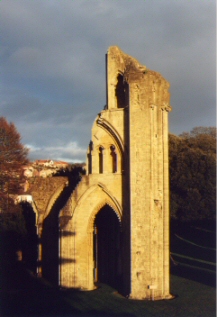Archaeology at Glastonbury Abbey on-line
Trustees of Glastonbury Abbey, 2007. (updated 2010) https://doi.org/10.5284/1000292. How to cite using this DOI
- Archive introduction
- Great Church report
- Lady Chapel report
- St Patrick's Chapel report
- Undercroft report
- Topographic Survey
- Photogrammetric Survey
Data copyright © Trustees of Glastonbury Abbey, Individual Authors unless otherwise stated
This work is licensed under the ADS Terms of Use and Access.

Primary contact
Dr
John
Allan
Exeter Archaeology
The Custom House
The Quay
Exeter
EX2 4AN
England
Resource identifiers
- ADS Collection: 770
- DOI:https://doi.org/10.5284/1000292
- How to cite using this DOI
The Great Church
Overview

The three major surviving portions of the nave and transepts of Glastonbury Abbey are the two piers which supported the eastern side of the central tower, and a substantial length of the south wall of the nave which also formed the north wall of the cloister. In this report each fragment is studied and illustrated individually.
Each of the three fragments formed a part of the huge church built in a major campaign following the destruction of the Norman great church in a fire in 1184. Detailed study allows the progress of work to be understood more fully. At first, work evidently progressed rapidly; much of the crossing and the lower parts of the aisle wall appear to have been built by 1189. A number of building breaks indicate that subsequent work progressed in smaller stages, with subtle changes between phases. The report describes the character and form of the work, with evidence of masoncraft, such as tooling and course heights.
On their eastern side the tower piers retain evidence for the conversion of the choir under Abbot Monington in the 14th century; they also display traces of the fan vault added within the crossing in the early 16th century under Abbot Bere, who also added scissor arches below to support the extra weight. Further evidence for the character of the decoration, fittings, altars, and monuments of the chapels is also described. Evidence for the vaults added in the aisle and adjacent cloister, and for later uses of the wall, including damage from musket fire attributable to the Civil War, is described.




